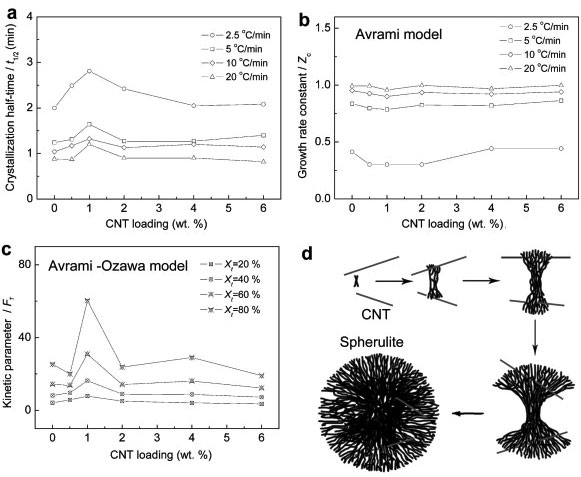由于碳纳米管具有高的表面能,使得其在复合材料制备过程中易于被聚合物包覆,显著降低聚合物复合材料的电热传输性能。本工作首次提出“碳纳米管-聚合物弱相互作用”设计思想,通过对CNT 进行表面处理降低CNT 表面能, 减少聚合物在CNT 表面的包覆, 形成有效的CNT 输运网络, 以显著提高CNT/聚合物复合材料的热、电传输性能。通过理论计算、比较CNT 与各类聚合物的相互作用及浸润性, 我们优选并制备石墨化CNT/聚甲醛复合材料,其具有较低的渗流阈值(0.5 wt.%)和高的电导率,归因于CNT-聚合物的弱相互作用、低的CNT 间接触电阻和高的结晶度。研究指出:通过调控CNT 与聚合物基体的表面性质、相互作用及浸润性, 可以有效地构建优化的CNT 输运网、获得性能优异的功能复合材料。 该工作“Increasing the electrical conductivity of carbon nanotube/polymer composites by using weak nanotube–polymer interactions”于2010年发表于国际著名期刊Carbon(影响因子4.89),相关系列工作在学术期刊“高等学校化学学报”、“ 新型炭材料”、“ Carbon ” 和国际会议“ the 2nd international conference on nanomechanics & nanocomposites”发表;硕士研究生论文“碳纳米管和石墨烯复合材料的电学性能研究”于2010年被评为辽宁省百篇优秀硕士学位论文。 
Figure 1. Effects of g-CNTs on crystallization rates represented in terms of: (a) crystallization half-time t1/2, (b) growth rate constant Zc, and (c) kinetic parameter FT. (d) A schematic of the interaction between CNTs and POM fibrils during crystallization. 
Figure 2. SEM images of g-CNT/POM composites with 1 wt.% CNT loading amount (a–c) at different magnifications. (d) A structural model illustrating that the g-CNTs unwrapped by insulating polymer lie between spherulite fibrils and form a CNT–spherulite interpenetrating network. (e) Degree of crystallization of the g-CNT/POM composites. 发表论文刊物:Y. Zeng, P. F. Liu, J. H. Du, L. Zhao, H. M. Cheng*. Increasing the Electrical Conductivity of Carbon Nanotube/Polymer Composites by Using Weak Nanotube–Polymer Interactions, Carbon, 2010, 48: 3551-3558. | 

